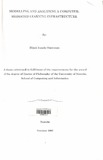| dc.description.abstract | Keywords: ICT, E-Iearning, Internet, Pedagogy, Content Calibrator,
Content Representation Model, Scenarios, Instructional Design,
Modelling.
The convergence of technologies of telecommunications, computing,
microelectronics and the Internet into what is commonly referred to as
information and communication technologies (ICTs) has had profound
impact on the way we teach and learn. This has created an information
revolution within an optimistic global society that has embraced virtual
learning environments in the provision of courseware. This notion
presents opportunities and challenges to universities and colleges of
higher learning worldwide. In response, most of such institutions have
embarked on both on-campus and off-campus online education in one form
or another to extend their services to greater number of students within
what could be described as the Socrates' Athens great school of modern
times.
In this research, one such instructional infrastructure has been developed
and it has been used to design and develop an e-lcarning system that aims
to enhance flexible learning opportunities within the context of a
university setting. The system comprises two main modules: a back-end
module, which supports server functionalities and houses the
representation model and the front-end module for learner interaction
with the system and upon which the score calibrator model is a
substratum. These two models - the representation model and the score
calibrator model- rely on input from a self-learning subsystem within the
e-Iearning system that in turn captures its input from cookies and
dynamic learner variables such as pace of learning, durations of
continuous use, post-test scores; together with static variables such as
learner-entry behaviour and learner goals and background. Whereas the
score calibrator is a computer-based model that maps a score to a specific
content representation hence being able to associate learning objectives
with the level of mastery of content using the post-test scores, the
representation model, at any given time t, supports a finite but dynamic
number of content representation and presentation scenarios which
characterize the persona of a specific homogenous learner groupg.
Unified Modelling Language together with the Object Orientation
approach was applied in designing the system while the web application
was designed using hierarchical hypertext organization model for the
overall site with 'linear with options and side trips' for the various
modules. A variety of programming tools were used for the
implementation.
The system has been subjected to a three-stage pilot implementation
process in which learners were asked to evaluate the various aspects of
the e-learning system. Two cohorts of students comprising Introductory
students doing a diploma in a humanities program and another
comprising Bachelors students doing a Computer Science course, were
used for the experiment. Purposeful sampling technique was used to
select participants from the introductory group of students while random
sampling method was used to select the advanced students who
participated in the e-learning experiments. Each of the two cohorts were
divided into two groups. Paired groups - comprising a group from either
cohort - went though the e-learning course while the other pair took the
face-to-face option. Quantitative as well as qualitative data were collected
and analysed. | en |

